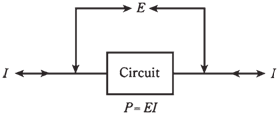Power and resonance in ac circuits:
The biggest challenge the engineer's is the problem of efficient energy transfer. This is the major concern at the radio frequencies. However audio design engineers, and even the utility companies, are to be concerned with the alternating current circuit efficiency as it translates into energy conservation.
The other important phenomenon, especially for radio-frequency engineer, is resonance. This is electrical analog of the reverberation you are familiar with if you have ever played the musical instrument. The last 3rd of this chapter discusses resonance in the series and parallel circuits.
What is power?
There are many different ways to define power. The applicable definition relies on the type of circuit or the device in use.
Energy per unit time
The all encompassing definition of power, and one commonly used by the physicists, is this that Power is the rate at which energy can be expended. The standard unit of the power is watt, which is abbreviated W; it is equivalent to 1 joule per second.
This definition can be applied to motion, electricity, radio waves, chemical effects, sound, light, ultraviolet, heat, and X rays. In all the cases, the energy is used up somehow, converted from 1 form into another form at the certain rate. This expression of power refers to the event which takes place at some definite place.
At times the power is given as kilowatts, megawatts or gigawatts. It might be given as milliwatts, microwatts, or nanowatts.
Volt-amperes
In direct current circuits, and also in alternating current circuits having no reactance, power can be defined in this manner: Power is product of the voltage across a circuit or component, times the current through it. Mathematically this can be expressed as P = EI. If E is in volts and I is in amperes, then P is in volt amperes (VA). This translates into watts at the time when there is no reactance in the circuit. The root-mean-square (RMS) values for the voltage and current are always used to derive effective, or average, power.

Figure: When there is no reactance in a circuit, the power, P, is the product of the voltage E and the current I.
Like joules per second, volt amperes, called as VA power or apparent power, can take several forms. A resistor converts electrical energy into heat energy, at the rate which depends on the value of the resistance and the current through it. Light bulb converts electricity into light and heat energy. A radio antenna converts high frequency alternating current into radio waves. A speaker converts low frequency alternating current into sound waves. The power in these forms is the measure of intensity of the heat, radio waves, light, or sound waves.
The VA power can be explained as the rate of energy expenditure definition does not encompass. This is reactive or imaginary power.